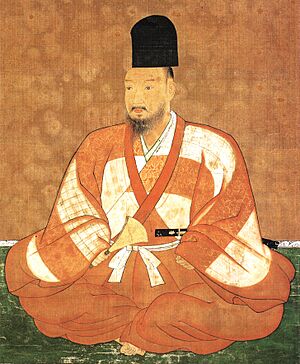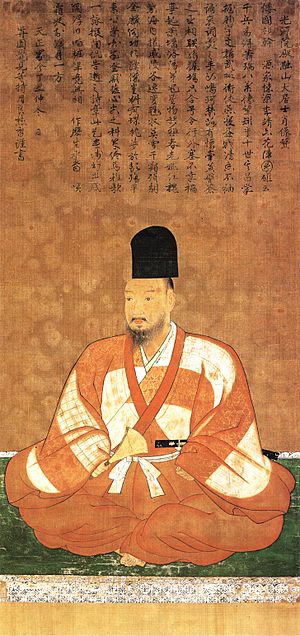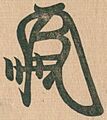Ashikaga Yoshiteru facts for kids
Quick facts for kids
Ashikaga Yoshiteru
足利 義輝 |
|
|---|---|
 |
|
| Shōgun | |
| In office 1545–1565 |
|
| Monarch | |
| Preceded by | Ashikaga Yoshiharu |
| Succeeded by | Ashikaga Yoshihide |
| Personal details | |
| Born | March 31, 1536 |
| Died | June 17, 1565 (aged 29) |
| Nationality | Japanese |
| Spouse | Daughter of Konoe Taneie |
| Parents |
|
| Signature |  |
Ashikaga Yoshiteru (足利 義輝, March 31, 1536 – June 17, 1565) was a powerful leader in old Japan. He was the 13th shōgun of the Ashikaga shogunate. A shōgun was like a military ruler of Japan. Yoshiteru ruled from 1546 to 1565. This was during a time called the late Muromachi period.
He was the oldest son of the 12th shōgun, Ashikaga Yoshiharu. His mother was a daughter of Konoe Hisamichi. When he became shōgun in 1546, he was only 11 years old. His first name was Yoshifushi. Later, in 1554, he changed it to Yoshiteru. His childhood name was Kikubemaru. His younger brother, Ashikaga Yoshiaki, later became the 15th shōgun.
Contents
Becoming Shōgun
Yoshiteru's father, Yoshiharu, had to step down as shōgun in 1546. This happened because of a fight with Hosokawa Harumoto. So, Yoshiteru became the Sei-i Taishōgun. But like his father, he was a "puppet shōgun." This means other powerful people controlled him.
He was only 11 when he took the role. His special ceremony happened in Sakamoto, outside Kyoto.
Soon after, his father made a deal with Harumoto to go back to Kyoto. But then, a powerful leader named Miyoshi Nagayoshi turned against Harumoto. Nagayoshi joined forces with Hosokawa Ujitsuna. They started a war that forced Yoshiteru, his father, and Harumoto out of Kyoto. In 1550, Yoshiteru's father, Yoshiharu, died without being able to return home.
In 1552, Yoshiteru made peace with Nagayoshi. He was able to go back to Kyoto. But the next year, Yoshiteru and Harumoto started another war. They wanted to remove Nagayoshi's power. At first, things went well for Yoshiteru. He had help from Rokkaku Yoshikata. But in 1558, Nagayoshi fought back. Yoshiteru was forced out of Kyoto again.
Nagayoshi didn't kill Yoshiteru. He was afraid of being blamed for killing a shōgun. Instead, they made a deal. Yoshiteru could return to Kyoto, but Nagayoshi would still be in charge. Yoshiteru was just a figurehead.
Finally, in 1565, Matsunaga Hisahide attacked Kyoto. This led to a sad end for Yoshiteru. He chose to take his own life.
How He Ruled
Yoshiteru was surrounded by powerful lords called daimyō. These daimyō often just wanted to use the shōgun's power for themselves. But Yoshiteru still worked hard to make the shōgun's authority strong again. He did this by talking to leaders all over Japan.
He tried to make peace between famous daimyō like Takeda Shingen and Uesugi Kenshin. He also talked with Shimazu Takahisa, Ōtomo Yoshishige, Mōri Motonari, and Amago Haruhisa. Because of his efforts, many daimyō started to respect the shōgun's power again.
Yoshiteru didn't have many resources. But he found ways to show his influence. He would give his special kanji character "輝" to samurai like Mōri Terumoto. This made him like a respected leader or "godfather." Many people think Yoshiteru was the last truly effective shōgun. Even famous leaders like Oda Nobunaga and Uesugi Kenshin visited Kyoto to show him respect.
End of His Rule
In 1564, Nagayoshi died from an illness. Yoshiteru saw this as a chance to take back full power. But Matsunaga Danjo Hisahide and three leaders from the Miyoshi clan (called the Miyoshi Triumvirs) wanted to rule. They wanted to control things just like Nagayoshi had. They were ready to do anything to remove Yoshiteru. They wanted to make Ashikaga Yoshihide their puppet shōgun.
In 1565, Matsunaga Danjo Hisahide's son, Matsunaga Hisamichi, and Miyoshi Yoshitsugu attacked the buildings where Yoshiteru lived. These buildings later became Nijō Castle. No help arrived in time from the daimyō who might have supported him. Yoshiteru and his few soldiers were defeated by the Miyoshi forces.
Three years later, his cousin Ashikaga Yoshihide became the 14th shōgun.
His Legacy
Yoshiteru was known for his strong will and his amazing sword skills. He practiced sword fighting often. Because of this, people called him the "Kengo shōgun" (剣豪将軍). This means "Sword Master shōgun." He was more like a true samurai and warrior than any shōgun since Ashikaga Takauji. One of his sword teachers was Tsukahara Bokuden. He was the founder of a famous sword school.
Yoshiteru's rule was highly praised. But being killed despite all his efforts sadly destroyed the little power and respect he had built up.
A poem called a waka is said to have been written by Yoshiteru before he died. It shows how much he hoped for, and how limited his achievements were.
| Kanji | Rōmaji | English |
|---|---|---|
| 五月雨は 露か涙か 不如帰 我が名をあげよ 雲の上まで |
samidare wa tsuyu ka namida ka hototogisu waga na o ageyo kumo no ue made |
The May rain falls, and is it my tears or the mist that surround me? Hototogisu, take my name and soar above the clouds |
Family
- Father: Ashikaga Yoshiharu
- Mother: Keijuin (1514–1565)
- Wife: daughter of Konoe Taneie
- Children:
- Teruwakamaru (1562–1562)
- Ashikaga Yoshitaka
Eras of Yoshiteru's Rule
During Yoshiteru's time as shōgun, Japan used different era names or nengō.
Famous Swords
The "Mikazuki Munechika" is one of Japan’s Tenka-Goken. These are five of the greatest swords in Japan. The Mikazuki Munechika is thought to be the most beautiful. This long samurai sword was made by Sanjô Munechika. It was named "Mikazuki" because its shape looks like a crescent moon.
Like all the Tenka-Goken, the Mikazuki Munechika is a National Treasure of Japan. You can see it at the Tokyo National Museum.
This sword has a long history. In the mid-16th century, it belonged to the Ashikaga family. Shōgun Ashikaga Yoshiteru used this sword to defend himself. This was during the attack on his palace by the Miyoshi family. After he died, the sword was taken by Miyoshi Masayasu. The Mikazuki Munechika was passed to a few more owners. Eventually, it came to be owned by the Tokugawa clan.
Images for kids
See also
 In Spanish: Ashikaga Yoshiteru para niños
In Spanish: Ashikaga Yoshiteru para niños



